Thuja in a pot at home: from planting to leaving
Evergreens are attractive because they retain their appearance all year round. One of the representatives is thuja... It can be grown not only in the garden. Having planted the thuja in a pot, you can use it to decorate the garden in the summer and at home in the winter.
Content:
- Description and varieties
- Reproduction of thuja
- Planting and replanting
- Thuja care
- Thuja diseases and pests
- Using thuja
Description and varieties
Thuja belongs to the cypress family. Another name is iron tree. Under natural conditions, and this is Japan and North America, it can reach a height of 7 m.
Thuja is an evergreen plant, tree or bush with more than a hundred decorative forms.
Its branches are flat, the leaves are small diamond-shaped needles. They are located opposite and cover the branches with a kind of scales. Leaves resemble shingles in shape and placement. They also stack on top of each other, creating an intricate path. Cones are bent downwards, oblong in shape.
Young shoots are green. With age, they become woody and brown. In place of flower buds, after pollination with anthers, cones are formed. Their size is about 1 cm. They ripen in early autumn. Thuja leaves contain camphor oil. This is the reason for the pleasant smell that comes from the plant.
Thuja has several types:
- Western (tree of life).
- Chinese, or Sichuan.
- Korean.
- Japanese, or Thuja Standish.
- Folded (giant).
Nowadays, eastern thuja is increasingly grown as a pot plant. For this, breeders have created many dwarf forms. They are distinguished by the color of the leaves, which can be green, blue, golden or silver. There are also varieties with mixed colors.
Thuja can be grown in pots:
- Danica
- Folded Vipcord
- Folded Cagers Beauty
- Western Golden Globe
- Western teddy
- Western Miki
- Aurea Nana
- Dwarf
- Teeny Tim
- Little Giant
- Miriam
Reproduction of thuja
Reproduction of thuja can be carried out seeds, cuttings or branches and layering. But the process of growing thuja from seeds takes up to six years. In addition, maternal properties are not transmitted with this method of reproduction.
The seeds must be fresh. When kept warm, they lose their germination. To get the seeds out of your buds, you need to separate them. The removed seeds are dried, sifted through a coarse sieve. In regions where the snow lasts for a long time, you can tie the seeds in gauze and after the snow falls, bury them in a snowdrift to a depth of 30 cm.If this is not possible, because the snow cover does not last long, they are stratified by placing them in wet sand and placing them on a couple of months in a cellar or refrigerator. You need to check them periodically so that they don't get moldy or dry out.
When the seeds hatch, they are planted in the sand. Germinated at high temperature, covered with glass or film. If weather conditions permit, you can plant outdoors in loose soil with an admixture of sand, covered with a mini-greenhouse.
Thuja cuttings:
- Most often, thuja is propagated by semi-lignified cuttings. They are cut in cloudy weather or in the morning from the middle part of an adult plant.It is better not even to cut, but to pluck it with a sharp movement from top to bottom, so that at the end of the cutting there is a heel - a piece of bark from a branch. The larger it is, the higher the chances of rooting.
- Cuttings should be healthy, not very young or old. The lower branches with leaves are removed so that after planting they do not touch the surface of the ground. They are rooted in a specially prepared mixture. For its preparation, peat and sand are mixed in equal parts.
- It is advisable to place the prepared cuttings in a solution of Kornevin or another stimulator of root formation.
- They are planted in the ground, deepening a few centimeters and tilting at an angle of 60 °. Cover with a plastic bottle or jar. This will help maintain a humidity level of around 70% inside the mini greenhouse. The rooting temperature should be around 23 ° C.
- The shelter is periodically removed to spray the cuttings and ventilate the rooting area. If this is not done, mold can grow under the shelter and the cuttings will die. The shelter is completely removed after the thuja grows.
Reproduction by branches is carried out in almost the same way as by cuttings. In this case, the use of Kornevin is mandatory. Before planting, sand and dishes must be disinfected with a solution of potassium permanganate.
It is difficult to propagate thuja by layering due to the small amount of free space in the pot around the trunk. You can try to put another pot next to it, into which to pin the layering, having previously plucked the leaves from the branch. Sprinkle with soil on top. Watering. After root formation, the cuttings are separated from the mother plant.
Planting and replanting
Soil for growing young thuja should be loose, allow moisture and air to pass through to the roots of the plant. You can buy it for growing thuja at a flower shop by choosing a composition for conifers. You can cook it yourself. Mix 2 parts of coniferous, 4 parts of leafy earth. Add half a portion of the sand.
Containers or pots for dwarf thuja can have a volume of 20-30 liters. For larger plants, dishes for 100-150 liters are needed. In this case, the plants can be left outside for the winter. A pot for planting a thuja is taken 3 times more than a clod of earth with roots. A drainage layer is placed on the bottom of the pot. It will prevent moisture from stagnating near the plant's root system. You can make it from pieces of foam or cut corks. You can add gravel, but this will significantly affect the weight of the pot.
Set the thuja so that the root collar is at the level of the topsoil. Watering. Install in a fairly bright place, but away from direct sunlight. Even northern windows can be used, but the amount of light should be sufficient. Otherwise, the crown will become sparse and ugly.
The first years of life are transplanted every year, while increasing the diameter of the pot by several centimeters.
The soil for the older thuja is not needed the same as for young plants. Mix 3 parts of peat and one part of sand and leafy earth. The tree is installed so that the ground level remains the same as before transplanting. If you deepen the root collar further, the root can rot. The root system of the thuja is at the top of the soil. Therefore, it is impossible to loosen it strongly, so as not to damage the roots.
Thuja care
How to properly care for a plant:
- In summer, thuja care consists in regular watering. It must be protected from direct sunlight. Feels good in the garden, in the light shade of trees. Poorly tolerates heat and draft.
- In winter, it is necessary to organize a temperature regime for thuja from 5 to 15 ° C. If left in a room with high temperature and low humidity, young shoots can dry out. You cannot install a pot of thuja near heating radiators or stoves.
- You need to water less often in winter, making sure that the clod of earth in the pot does not dry out. Excess moisture with frequent watering can provoke root rot.
- Thuja in containers of sufficient volume can be left in the garden for the winter. In the first year, even before the onset of frost, they are wrapped in non-woven material. A thick board is laid under the bottom. After the snow falls, make sure that its layer on the soil in the container is at least 20 cm. The next wintering should pass without complications. If, of course, there is snow outside and the frost does not drop below 20 degrees. Therefore, it is still better to take care of the shelter with foam rubber or other insulation.
- Thuja reacts well to spraying with water at room temperature. This is especially necessary in winter, if there is no way to ensure a drop in temperature. For thuja, spraying is preferable to watering.
- Thuja is fed once a month in the spring and summer. Fertilizer for conifers is heavily diluted so as not to cause accelerated growth of thuja.
- Thuja lends itself well crown formation... Use pruning or pinching of branches. In this way, you can form a plant with the desired crown shape. It can be a ball, cone, pyramid. You can create a plant with or without a stem.
Diseases and pests
Young thuja branches can be damaged by the omnivore aphids... It settles at the ends of young shoots with the help of ants, which transfer it to the bush. Breeding, it sucks juice from young shoots. As a result, they stop growing and dry up. The tree loses its decorative effect, it may even die. You need to fight aphids by treating the plant with insecticides according to the scheme specified in the instructions for the drug.
As a result of excessive watering, the roots or trunk can rot.
Needle-gnawing leaf rollers and speckled moths, root and stem scale insects, and thuja bast beetle can damage the leaves of thuja. They are processed with Fufanon.
There are few diseases of thuja. They are mainly of fungal origin, for example. Brown mold. You need to deal with them by spraying after 10-14 days. fungicides... It can be a preparation for indoor plants Foley, Karbofos, an organic fungicide Fitosporin.
Using thuja
Thuja pleases with its appearance all year round. After all, she does not shed leaves. It can be used as a substitute for a Christmas tree by decorating with toys and a serpentine. Phytoncides, which secrete thuja leaves, purify the air, destroying pathogens. In addition, it emits a pleasant aroma. It has a positive effect on the nervous system of others.
Thuja needles are used to make preparations that stimulate the nervous and cardiovascular system.
Thuja juice has an antiseptic and hemostatic effect. Thuja-based preparations help in the treatment of colds due to diaphoretic and expectorant effects. Use a decoction of thuja branches to strengthen hair. However, in large quantities, thuja essential oils are poisonous. Therefore, they should not be used by pregnant women with epilepsy.
In summer, thuja pots can be used to decorate the yard by placing them in shaded areas. In winter, they are taken to the house, where they look great against the background of flowers and deciduous plants. They will feel even better on insulated loggias or in a winter garden.
More information can be found in the video:



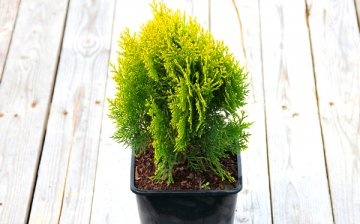
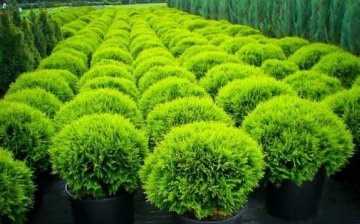
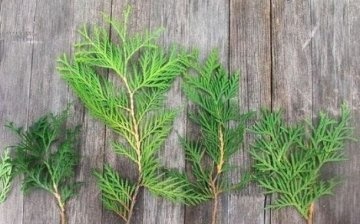
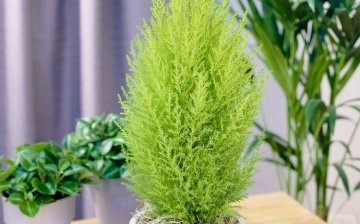
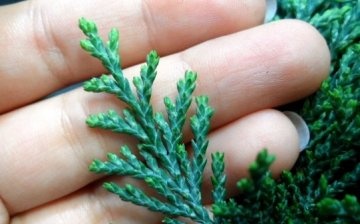
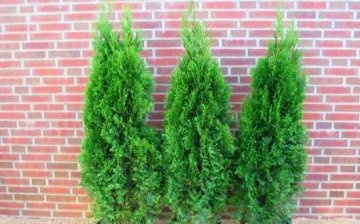
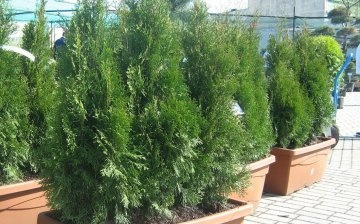







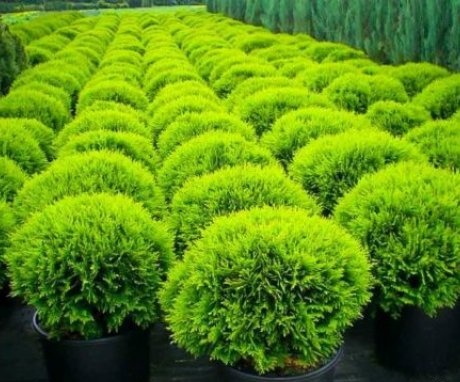
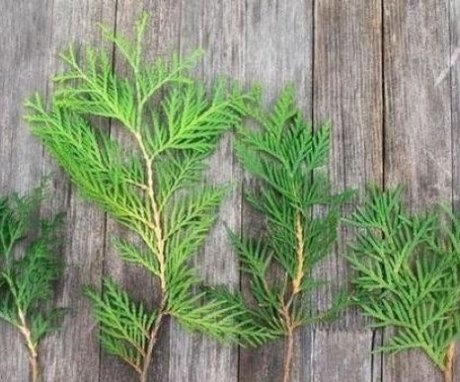
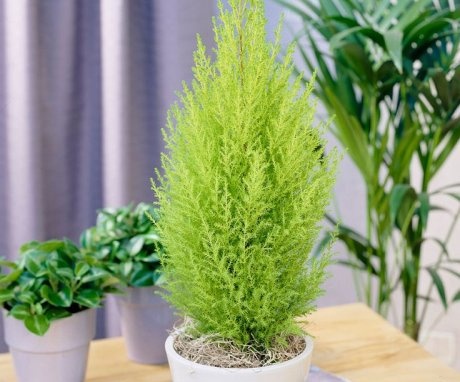
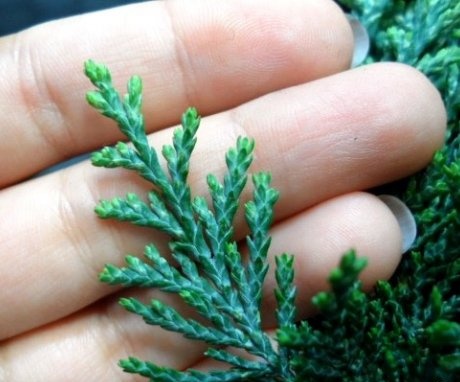
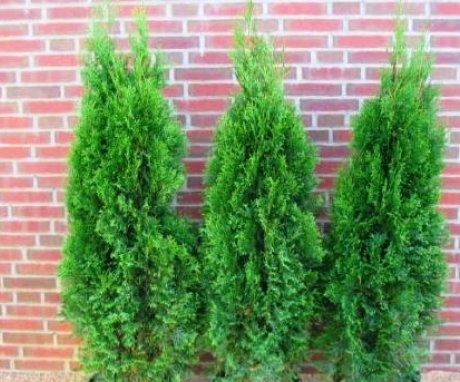
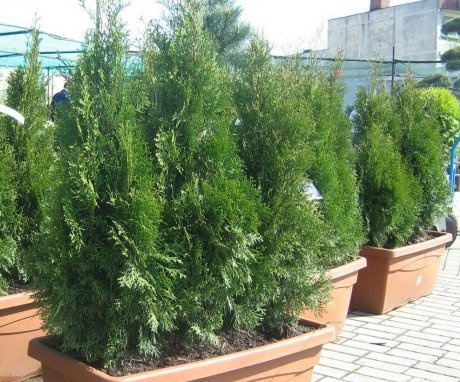
Just recently I saw a little thuja in a regular store. Even then I wondered if she would survive in the room and what to do when she started to grow. But it seems to me that the variety was not indicated on the label.
A plant for an amateur. It seems boring to me to decorate the local area or as a houseplant in a pot. Perhaps because in our region, thuja can be found on almost any street in the city.